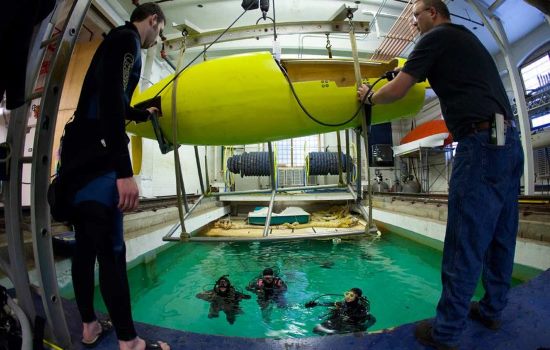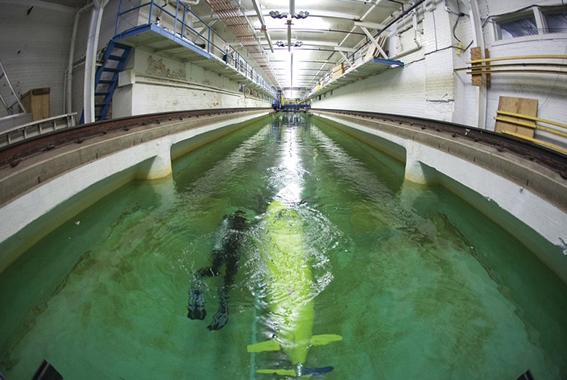Located at the University of Michigan in Ann Arbor, the recently renovated Aaron Friedman Marine Hydrodynamics Laboratory features a full suite of labs and facilities to enable classic naval architecture experiments. The test lab supports the school’s education mission, with commercial and government-sponsored research conducted in areas such as calm water resistance, seakeeping, and propeller tests.
Built in 1904, the lab’s prized 360-foot (109.7 m) long, 14.5-foot (4.4 m) deep “tow tank” was the first university-affiliated facility of its kind in the United States, and it remains the largest. The concrete basin is equipped with wave generators and a range of sensors for performing experiments to aid in designing ships and other marine craft. But consistent experiments and water exposure require regular maintenance, particularly when it comes to waterproofing the substrate. As part of the latest renovation, a six-man crew from nearby Michigan contractor BnE Services LLC got the call.
“It was a fast-paced project, with difficult time constraints from the start in order to complete it,” said Brian Anton, owner of the contracting company. “The owner needed to utilize the facility so that it could honor testing deadlines for its clients.” As such, specifications called for the $306,000 basin job to be completed within two months.
Enclosed Environment
In addition to efficiency, safety was another paramount consideration for the crew from the moment they arrived at the jobsite. The indoor area was considered a confined space, so ladders and scaffolding systems were placed at exits and air monitors were used to ensure there were no noxious gases or oxygen deficiency in the work area.
“The existing coating had low levels of lead content, so the water from the blasting and debris needed to be collected and separated by solids and liquids, and then disposed in proper containers and taken to an approved disposal location,” Anton said.
Considering the safety concerns, proper personal protective equipment (PPE) was also essential. However, specifics varied based on the stage of the project. Respirators, Tyvek suits, rubber gloves, face shields, ear protection, and hard hats were worn during the coating removal process, while pants, high-visibility shirts, safety glasses, hard hats, hand protection, and work boots were required for the installation of the new system.

Since the project was completed inside a building with controlled temperatures, weather did not pose an issue. In addition, the solvent-free and odor-free nature of the waterproofing product helped reduce preparation needs, Anton explained.
Blasting Off
With those safety precautions taken, the crew first needed to remove the lab’s existing coating system before it could install a new one. The existing substrate was cast-in-place concrete with cementitious waterproofing, which had to be removed via high-pressure waterjetting. To do this, the crew utilized a 40,000-psi (275.8 MPa) water blaster from NLB Corp. that consisted of a high-pressure pump, two blasting wands for horizontal surfaces, and a hand lance for vertical surfaces.
The unit also included a vacuum recovery system, which sucked up all the liquid and solid waste into a container. From that container, the crew pumped out liquid waste into proper disposal containers, while the solids, such as coating solids, flakes, and surface preparation residues, were shoveled out.
“Overall, the substrate was in good condition except for one area where an addition was added to the existing basin, and the concrete was soft and shaling upon removal,” Anton said, noting that the lab’s most recent renovation before this job was in 2006. In the soft area, the crew injected about 100 linear feet (30.5 m) of De Neef urethane grout from GCP Applied Technologies to address concerns over water stoppage.
Meanwhile, there were other cracks at various locations around the concrete basin where water stoppage was not a concern. For those, about 300 linear feet (91.4 m) of cracks were routed with a “V-Blade” knife, followed by the application of a Sikaflex-2c NS EZ Mix urethane sealant from Sika Corp. in groove joints. This was designed to allow the waterproofing membrane to bridge the surface, according to the contractor.
Fleece Layering
The selected waterproofing solution was the Kemperol 2K-PUR cold liquid-applied reinforced membrane from Kemper System. Described as a fleece-reinforced system based on polyurethane resin, the product is often used for wet environments. The BnE crew had prior experience working with the technology, since the company is a Kemper System-approved applicator.
Using specialty 7-inch (17.8 cm) Kemper roller skins and frames for the main basin field and 4-inch (10.2 cm) rollers for detail work, the crew worked in segments through the basin. They first coated the cleaned substrate with the epoxy-based Kempertec EP Primer at a rate of 68 square feet per gallon (1.7 m2/L), using surfacing sand broadcast into the primer to help with adhesion.
Once the primer cured, which took at least 12 hours, the crew installed the Kemperol 2K-PUR liquid waterproofing solution with rollers while applying the Kemperol 165 reinforcing fleece into the wet layer. Then, immediately after the reinforcing fleece was put down, the crew applied another coat of the Kemperol 2K-PUR over the fleece. Excluding the primer, the total combined thickness of the 2K-PUR system was approximately 80 mils (2,032.0 microns). “Adjacent rows are overlapped, so the installed membrane created a seamless surface for monolithic protection,” Anton explained.
According to the contractor, the curves of the basin made it challenging to install the system where the basin’s floor met the outside wall. The smaller rollers were used in these areas, as well as to detail around one main drain, a water inlet, and six steel columns.
Anchors Aweigh!
It was a slow, steady, and methodical process, but the six-man crew finished the job within two months — both on time and on budget! The expediency of the waterproofing crew’s installation allowed the remainder of the broader lab renovation project to remain on course, and the lab officially reopened for business in an April 2018 ceremony.
“These renovations have reinvigorated it for a new generation of students and visitors and provided a fitting showcase for the premier naval architecture school in the United States,” said Alec D. Gallimore, dean of Michigan’s engineering college.
Despite over a century of constant water exposure, the diligence paid by the school to proper maintenance and the expertise of crews such as BnE’s waterproofing applicators allows the lab to continue running in peak form today. And just like many of the vessels designed at the site, the BnE crew was ultimately cleared for departure and ready to set sail for its next job.
